

Five Fabulous Favorite Fotos (From Fischbeck)
The Internet constantly evolves. I remember when I thought that upgrading from a 14.4K modem to 28K was like going from riding a wagon to flying in a spaceship. Back when everyone connected to the Internet through AOL or Prodigy or CompuServe, back when your browser choices were limited, Flash had not been invented, and animated gifs were all the rage, it still seemed like a pretty good time.
We launched NHRA.com back in mid-1995 probably before a lot of the public was technologically ready for it. We envisioned event photo galleries and, sometime, maybe even video clips, but at the slow transfer speeds of the early ‘90s, that was a dream. We first started putting photos with our race reports back in 1998. They were supplied by Pontiac –- through Les Welch, as I remember –- and Pennzoil, but we only had a few. When Rob Geiger came to work for me in 1999 -- and by this time broadband was coming into its own and digital cameras were still in their infancy -- Rob shot photos for us in addition to his reporting. The camera was a pretty low-buck Olympus, a plasticky piece of junk with a shutter speed of molasses and a built-in delay between pressing the button and the photo being snapped that made shooting photos pretty tricky. Still, we got by.
 |
In the middle of the next year, we hired Mike Fischbeck to do the picture taking. We knew Mike for a few years as he was an eager Web site builder back in the day – had even applied for the NHRA.com webmaster position before we hired James Roe in 1997. Mike was with us for two or three years before moving on –- he even made the news when he caught a crook at the races -- but we never forgot him. Here’s his story, and his Five Favorite Fotos.
“I started my love affair with going fast in the late ‘60s, a product of the late-‘60s/early ‘70s Chicago street racing scene. You would make the circuit of Skip's, Super Dog's, Duke's, Flukie's, and Big Boy. You would do the south side Fridays and the north side Saturday and either Leek's Byron Raceway or 'Broadway Bob's' Union Grove on Sunday. I’m a huge fan of the carbs and gas crowd and the run-what-you-brung deal. I got involved with NHRA back in the Internet's infancy, but I’ve done everything from sweeping the floors to running a buggy to running several racers' Web sites while working for the dotcom to running a complete facility. The people who have helped me through this journey are numerous, but the main players are Lee Feret, Bob Metzler, Jim Wick, pro-stock.com, Rob Geiger, Phil Burgess, WJ Enterprises, all of the Safety Safari guys, Richard Brady, Charlie Allen, and Mr. Wally Parks, because without his vision, I wouldn't be writing this.”
| “My favorite photo of all time is of 'the Professor,’ Warren Johnson, and I've taken a few of him as I am a former student of WJ Enterprises university. The race was the 50th anniversary race in Pomona in 2001. The camera was, by today's standards, a disposable: NHRA's trusty old Olympus. Panning with it was not easy, but this is what I got. At the time a Nikon 950 I believe, as used then by Auto Imagery's Dave Kommel, was the best in use.” | 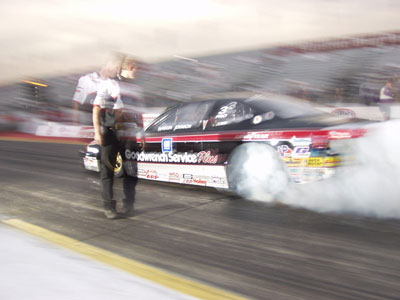 See bigger |
|
|
|
| Butterflies WIDE open, flames over the roof ... Del Worsham, 2007 at the Checker Schuck's Kragen NHRA Nationals, at Firebird Int’l Raceway, my former home track. I had the pleasure of working for Charlie Allen and Firebird Int’l for several years, but this was as far down the track as we were allowed to shoot, about 270 feet. I knew there would be no other light except mine. This was shot with a Nikon D-170, 200 at F4. | 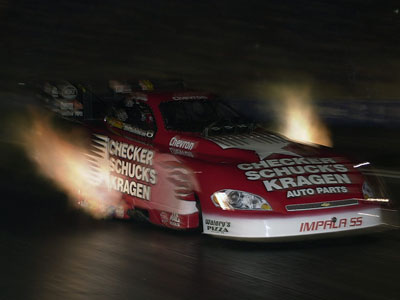 See bigger |
|
|
|
| “Johnny 'Nitro Fish' Gray, at least how he looked back in 2001. With my last name there has to be at least one 'Fish' foto, and this is still my favorite. Header flames over the roof, it's Pomona in the summer, again at NHRA's 50th. Plus John is a true gearhead in my book; it makes no difference to him whether it has carbs and gas or fuel and screw, just as long as it's fast. This too was shot with NHRA's old and trusty Olympus about 70 feet out.” | 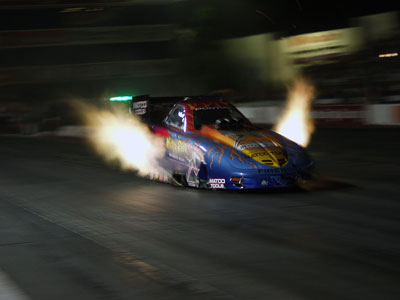 See bigger |
|
|
|
| “Show me the $$$! This is Indy 2006 and Force had just won the Skoal Showdown and was on his way to do TV. I was in Chi-Town when Force became the all time winningest driver, but this one wasn't rehearsed. He was really happy, and that is a boatload of cash for an old broken down truck driver. I was trying to get out of the way on the return road but grabbed this with a Nikon D-1 and a 28–70 lens.” | 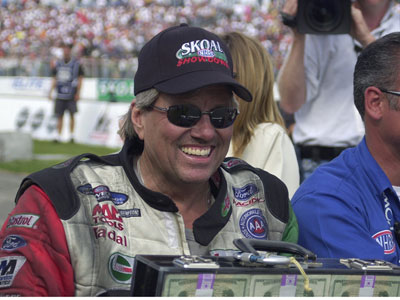 See bigger |
|
|
|
| “A true pro, Mr. Kenny Bernstein, and his Bud King dragster, tires a-blazing, the puff of a cylinder, no negative flash from the other side. Artsy, and Top Fuelers are the kings of the sport, are they not? Again in Pomona, still the 50th, and still the old trusty Olympus ... ” | 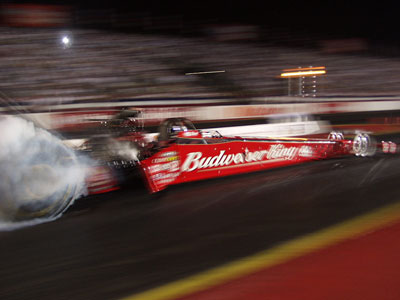 See bigger |
|
|
|

A quick dive into the mailbag …
As a follow-up to my entry on Bob Struksnes (March 10 Insider), Brett Nation tells me that “Backdoor Bob’s” last car, an Attebury-chassised machine that he campaigned in 1980, was driven pretty successfully the next season by a guy named Jeb Allen who did a little something called winning the world championship. Ron Attebury was a popular chassis builder in the 1970s – sort of like a Brad Hadman or Murf McKinney today. The recently deceased John Shoemaker, himself a pretty good chassis man, was a close friend and sounding board for Attebury. According to Nation, Jeb also ran the last car Attebury built, then retired and sold it to Arnold Birky, and that chassis was Ground Zero for Bobby Neal’s infamous Pomona explosion at the Finals in 1987. I also was passed along the URL to a interesting site that I’ll share Monday.
Wednesday’s piece on the demise of the slingshot was very popular, as I suspected it might be, and turns out a lot of you, like me, didn’t know all of the details. It was really fun to research and write. I did hear from designing god Steve Swaja, who offered some “trivial corrections” (his words) about Tony Nancy’s Wedge and some remembrances of its design that I’ll also share Monday. Don Roberts also wrote in to point out that Swingle wasn’t the only one who caught on to the slower steering ratio to calm the first rear-engine cars. Pat Foster and Woody Gilmore also caught on to that idea after wrecking their car at Lions.
If you’re close to the scene or frequent some nostalgia boards, you know the latest on “Patty Faster.” Keep him in your prayers.



















































